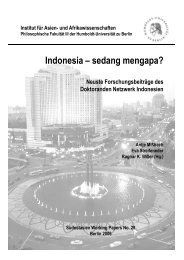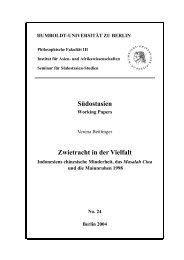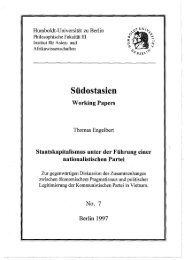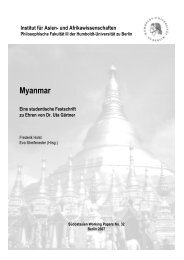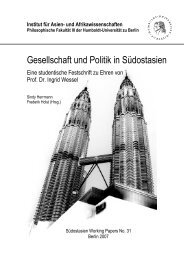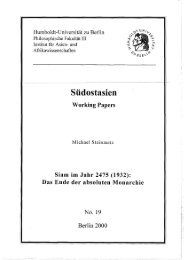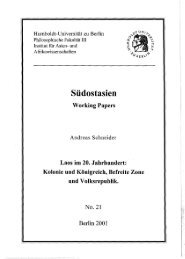Connecting the Philippines and Germany - HU Berlin
Connecting the Philippines and Germany - HU Berlin
Connecting the Philippines and Germany - HU Berlin
Create successful ePaper yourself
Turn your PDF publications into a flip-book with our unique Google optimized e-Paper software.
Government, Representation in <strong>the</strong> Spanish Cortes, Loss of her character as a Spanish province <strong>and</strong><br />
<strong>the</strong> declaration of her status as a colony, Reforms, Criticism, Influence of <strong>the</strong> Monastic Orders on <strong>the</strong><br />
material progress of <strong>the</strong> Isl<strong>and</strong>s, <strong>the</strong> <strong>Philippines</strong> compared with o<strong>the</strong>r colonies, etc.<br />
IV. Linguistics<br />
Classification of languages spoken in <strong>the</strong> <strong>Philippines</strong> Tagalog, Visayan, Ilocano, l’espagnol de kusina<br />
[literally Kitchen Spanish or <strong>the</strong> pigdin Spanish spoken in Cavite], studies on modern literature of <strong>the</strong><br />
Tagalogs, modern literature of <strong>the</strong> <strong>Philippines</strong>, religious books, etc V. Races <strong>and</strong> Independent Regions<br />
which includes all Muslim sultanates, independent tribes, Negritos, etc. 65<br />
The fifth part on Race <strong>and</strong> Independent regions was an afterthought, as seen in <strong>the</strong> correspondence<br />
between Rizal <strong>and</strong> Blumentritt. It was not in <strong>the</strong> original outline, suggesting that Rizal saw <strong>the</strong> Muslims<br />
of <strong>the</strong> Sou<strong>the</strong>rn isl<strong>and</strong> of Mindanao, as well as <strong>the</strong> non-Christian, non-Hispanized indios of <strong>the</strong><br />
mountains, differently from <strong>the</strong> lowl<strong>and</strong> Christian indios of which he was part. Note too that, as in <strong>the</strong><br />
annotations to Morga, Rizal did not refer to non-Christian Filipinos collectively as “Filipinos,” in <strong>the</strong><br />
way that he referred to <strong>the</strong> Hispanized indios of Luzon <strong>and</strong> <strong>the</strong> Visayas.<br />
More importantly, I have italicized some lines in <strong>the</strong> outline to stress Rizal’s linear conception of history,<br />
<strong>and</strong> how he uses <strong>the</strong> arrival of Spain as <strong>the</strong> turning point, <strong>the</strong> break in Philippine history that<br />
stunted <strong>the</strong> pre-Hispanic Philippine civilization. Colonization, according to Rizal’s view of history, led<br />
to <strong>the</strong> loss of both Philippine autonomy <strong>and</strong> its distinct character.<br />
Rizal’s survey <strong>and</strong> study of <strong>the</strong> Philippine past showed that all <strong>the</strong> chronicles on his country <strong>and</strong> people<br />
were written by Spaniards, <strong>and</strong> thus reflected <strong>the</strong>ir biases. Unlike neighboring countries, Java,<br />
Burma, or Vietnam, which had an abundance of ancient, pre-colonial, written texts, <strong>the</strong> <strong>Philippines</strong><br />
had nothing but <strong>the</strong> Spanish chronicles. Fur<strong>the</strong>r complicating <strong>the</strong> matter was <strong>the</strong> fact that Rizal attempt<br />
to write on <strong>the</strong> pre-Hispanic <strong>Philippines</strong> before <strong>the</strong> arrival of archaeology, <strong>and</strong> was thus left with no<br />
choice but to use Spanish written sources. In <strong>the</strong> course of his research, he constantly had to decide<br />
which sources to use for his history of <strong>the</strong> <strong>Philippines</strong>, but his patriotism largely determined his<br />
choice.<br />
65 Letter to Blumentritt, February 6, 1889. Ep. Riz. p.406.<br />
23



